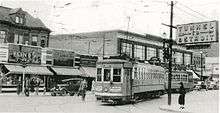Windsor, Ontario Streetcar System

Windsor, Ontario was the first Canadian city with an electric street car system, which was introduced in 1886.[1][2] Other Canadian cities soon followed suit, with St. Catharines in 1887 and Toronto in 1889.[1] By World War I, nearly 50 Canadian cities had streetcar systems in place.[3] By the time Windsor’s streetcar system was dismantled in 1937, the system’s scale was extensive and it serviced all 5 of the major riverfront communities of Windsor, Ford City (East Windsor), Sandwich, Walkerville and Ojibway.
Early Beginnings
The streetcar system adopted by the city of Windsor and surrounding towns was developed by Charles J. Van Depoele.[4] VanDepoele had immigrated to Detroit, Michigan from Belgium in 1874 to develop his electric system.[4] Windsor was the first city to adopt VanDepoele’s system, as well as the first in Canada to have any type of electric streetcar system.[4] Prior to the electric cars, a horse-drawn streetcar system had been in place since 1872.[1] The new railway began development under two companies, the Windsor-Walkerville Street Railway Company and the Windsor-Sandwich Street Railway Company until the two merged in 1891 to later become the Sandwich, Windsor, and Amherstberg Street Railway (S.W. & A.R.).[5] VanDepoele’s electric streetcar first ran in Windsor on June 6, 1886, servicing the small town nestled south of the Detroit River.[4]
Expansion
Although initially the track spanned only a small portion of Windsor along the Windsor-Detroit waterfront on Riverside Drive, the S.W.& A.R. began expanding its service southward with an extension along Ouellette Avenue in 1893.[5] The track started at the international ferry landing and went south, providing access to a popular race track, while simultaneously encouraging population growth south of the Detroit River where transportation was becoming readily available.[5]
The service began expanding from the small city of Windsor outward to the east and to the west to the towns of Sandwich, Walkerville, and East Windsor. Population was expanding in these areas largely due to the introduction of big industries in Windsor. Walkerville began expanding due to the Hiram Walker distillery and East Windsor because of the introduction of a Ford Factory in 1904.[6]
Subsequently, the S.W. & A.R. began expanding its track to these areas and to areas of dense population growth, creating access to much of the city and surrounding areas. People followed the track line, and the track line followed the people. Many Windsorites did not own automobiles, and found the streetcar a viable alternative to purchasing a new car. By 1921, the track had expanded to the towns of Amherstberg and Tecumseh at each end, measuring 37 miles in total.[5] An additional track, the Windsor Essex and Lakeshore Hallway Company, operated between Leamington, Essex and Kingsville.
As the automobile began rising in popularity and lowering in price, the use of the streetcars began to decline, despite the steady increase in population seen in Windsor at that time. In 1934 the company went out of business and its rails were incorporated into the system of the S.W.& A.R.[5]
Disintegration
The electric streetcar system provided an extensive and extravagant mode of transportation to the citizens of Windsor until the 1930s, when the Great Depression left the world in financial turmoil. The streetcars were expensive to repair and were beginning to deteriorate, and because of costs S.W. & A.R. began to cut down some of the less-travelled and less-profitable routes on the track.[5] The newly comprised City of Windsor, consisting of the Sandwich, Windsor, Walkerville, and East Windsor communities in 1935, was unable to bear the financial burden of the S.W. & A.R.[5]
Buses began to be considered as a cool viable alternative to streetcars, because they were much less expensive to purchase.[7] The S.W. & A.R. found that it would be less costly to purchase a set of buses than to repair the deteriorating rails.[5] It was also thought by many that it was contradictory to continue using electric streetcars instead of automobiles in the automotive capital of Canada, where automobile ownership was rising and providing stiff competition to public transportation.[5]
In 1937 the City decided to abandon the streetcar system in favour of a city bus system.[7] The last Windsor electric streetcar ran on May 7, 1939.[7] The rails were removed from the ground and a city bus system has been in place ever since. The only remaining rails can be found at the intersection of Sandwich Street and Mill streets in Windsor.
References
- 1 2 3 Harry Black, Canadian Scientists and Inventors. Markham: Pembroke Publishers Limited, 1997.
- ↑ "Remember This? Heading to Bellevue Park? Why not take a street car?". Soo Today. 2015-10-18. Archived from the original on 2015-11-05.
Windsor, Ontario was the first Canadian city with an electric streetcar system, which was introduced in 1886. Other Canadian cities soon followed, with St. Catharines in 1887 and Toronto in 1889.
- ↑ Kearney, Mark, and Randy Ray. Pucks, Pablum and Pingos. Canada: Dundurn Press, 2004.
- 1 2 3 4 Schramm, Kenneth. Detroit’s Street Railways. Chicago: Arcadia Publishing, 2006.
- 1 2 3 4 5 6 7 8 9 R. Markovich, “The Evolution of Public Transport Networks in Windsor, (Ontario), and London, (Ontario), 1872-1968.” MA diss., University of Windsor, 1971.
- ↑ Kreipke, Robert C. Ford Motor Company: The First 100 Years. Turner Publishing Company, 2003.
- 1 2 3 Plaut, Jonathon V. The Jews of Windsor, 1790-1990. Canada: Thistle Printing Limited, 2007.